
JunOS_2_routingessentials
.pdf
JUNOS Routing Essentials
Next Hop Required (contd.)
By default, the next-hop IP address of static routes configured in JUNOS Software must be reachable using a direct route. Unlike with software from other vendors, JUNOS Software does not perform recursive lookups of next hops by default.
Static routes remain in the routing table until you remove them or until they become inactive. One possible scenario in which a static route becomes inactive is when the IP address used as the next hop becomes unreachable.
|
for |
Reproduction |
Not |
|
|
|
|
Routing Fundamentals • Chapter 2–27
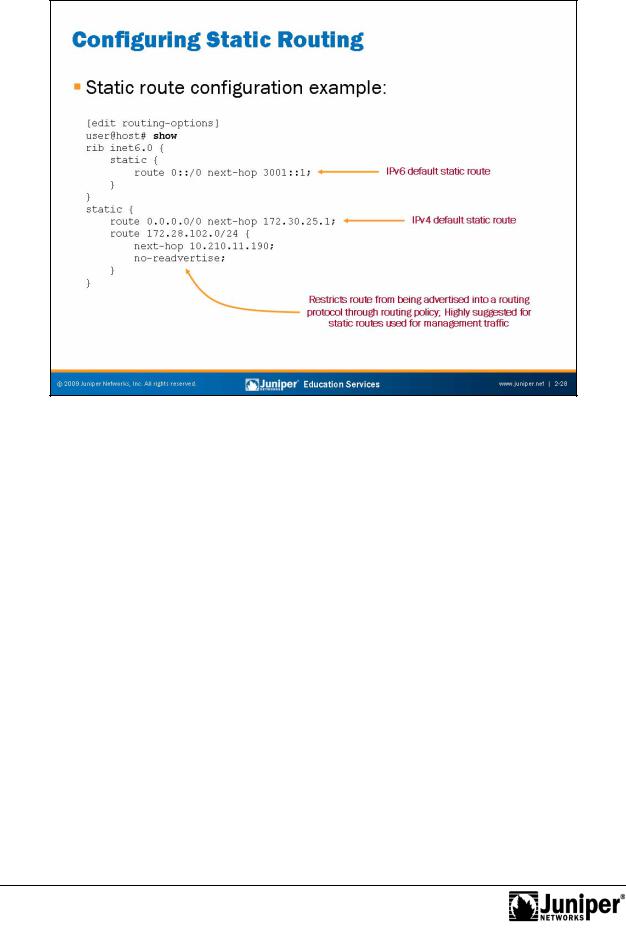
JUNOS Routing Essentials
Configuration Exampl : Static Routing
The slide illustrates theReproductionbasic configuration syntax for IPv4 and IPv6 static routes. The slide also highlights the no-readvertise option which prohibits the redistribution
of the associatedforoute through routing policy into a dynamic routing protocol such as OSPF. We highly suggest that you use the no-readvertise option on static routes that direct tra ic ut the management Ethernet interface and through the management netw rk.
Note hat IPv6 support varies between JUNOS Software platforms. Be sure to check the technical documentation for your specific product for support information.
Chapter 2–28 • Routing Fundamentals
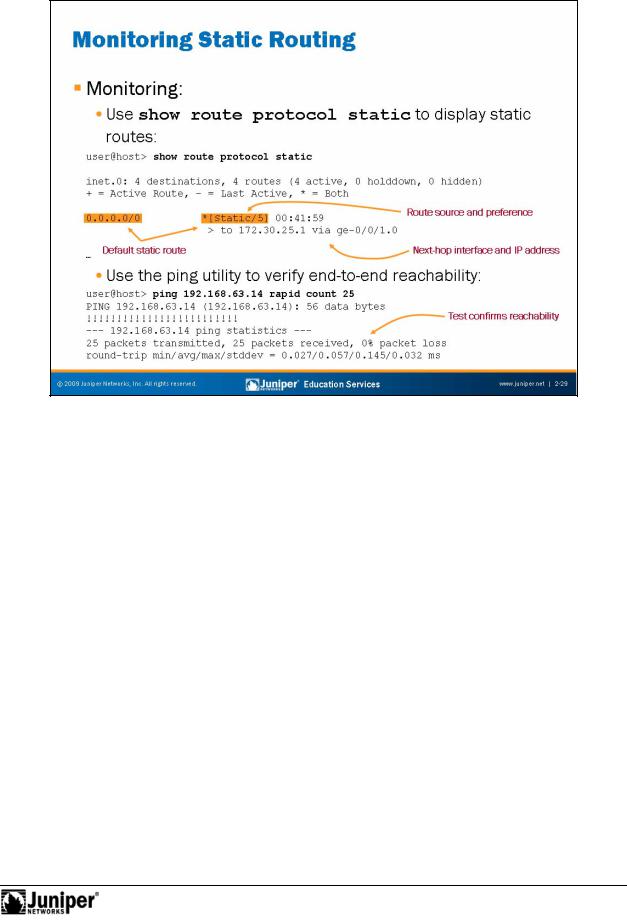
JUNOS Routing Essentials
Monitoring StaticReproductionRouting
The slide shows the basic verification steps when determining proper operation of forstatic outing.
Not
Routing Fundamentals • Chapter 2–29
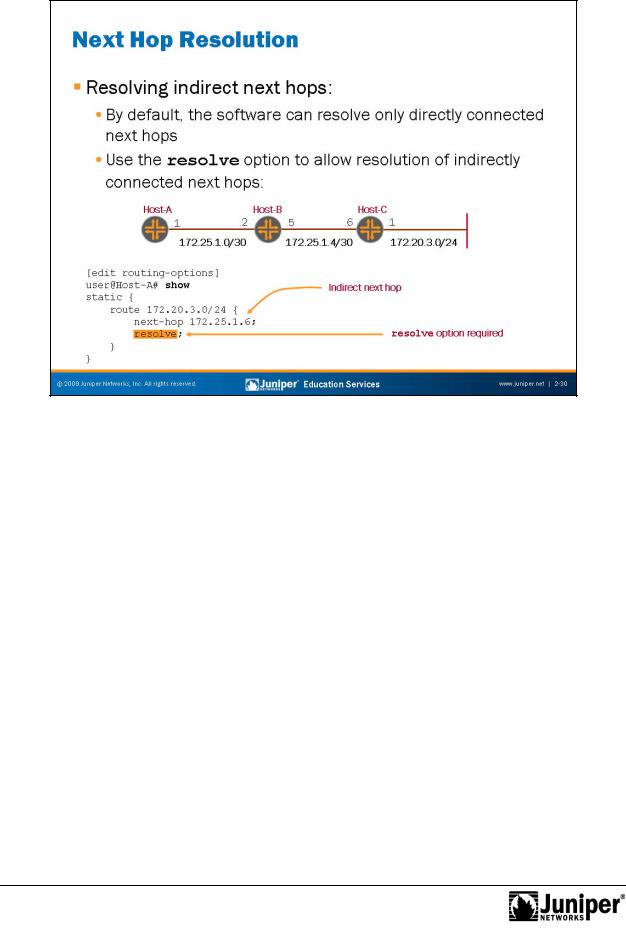
JUNOS Routing Essentials
Resolving Indirect NReproductionxt Hops
By default, JUNOS Software requires that the next-hop IP address of static routes be reachableforusing a di ect rout . Unlike software from other vendors, JUNOS Software does not perfo m ecu sive lookups of next hops by default.
As illustrated n the slide, you can alter the default next-hop resolution behavior using the resolve CLI ption. In addition to the resolve CLI option, a route to the
Notindirect next hop is also required. Indirect next hops can be resolved through another sta ic r u e or through a dynamic routing protocol. We recommend, whenever
p ssible, that you use a dynamic routing protocol as your method of resolution. Using a dynamic routing protocol, rather than a static route to resolve indirect next hops, dynamically removes the static route if the indirect next hop becomes unavailable.
Chapter 2–30 • Routing Fundamentals
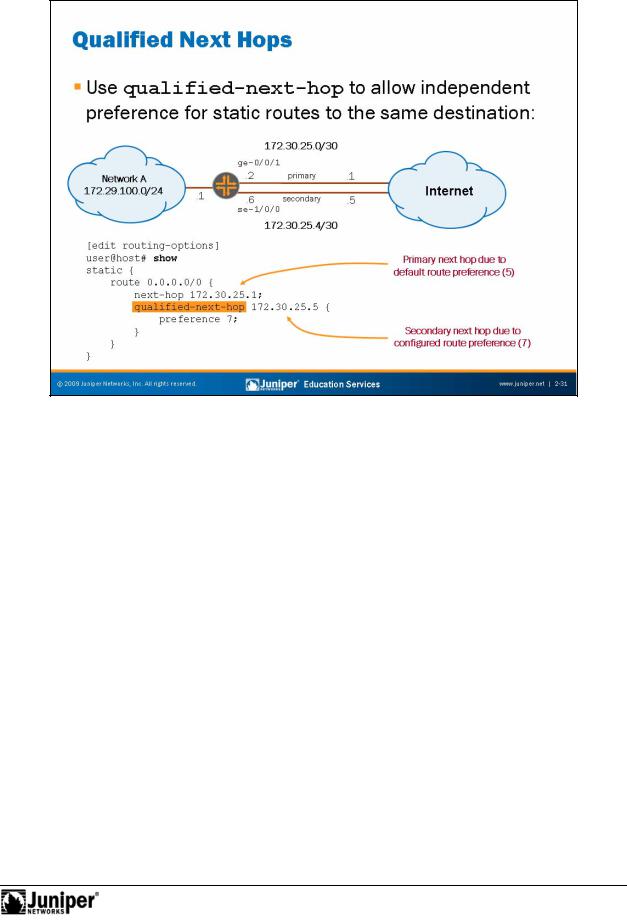
Not
JUNOS Routing Essentials
Qualified NextReproductionHops
The qualified-next-hop option allows independent preferences for static routes to the same destination. The slide shows an example using the qualifiedfor -next-hop option.
In the sample configuration shown on the slide, the 172.30.25.1 next hop assumes the de ault static route preference of 5, whereas the qualified 172.30.25.5 next hop, uses the defined route preference of 7. All traffic using this static route uses the 172.30.25.1 next hop unless it becomes unavailable. If the 172.30.25.1 next hop becomes unavailable, the device uses the 172.30.25.5 next hop. Some vendors refer to this implementation as a floating static route.
Routing Fundamentals • Chapter 2–31
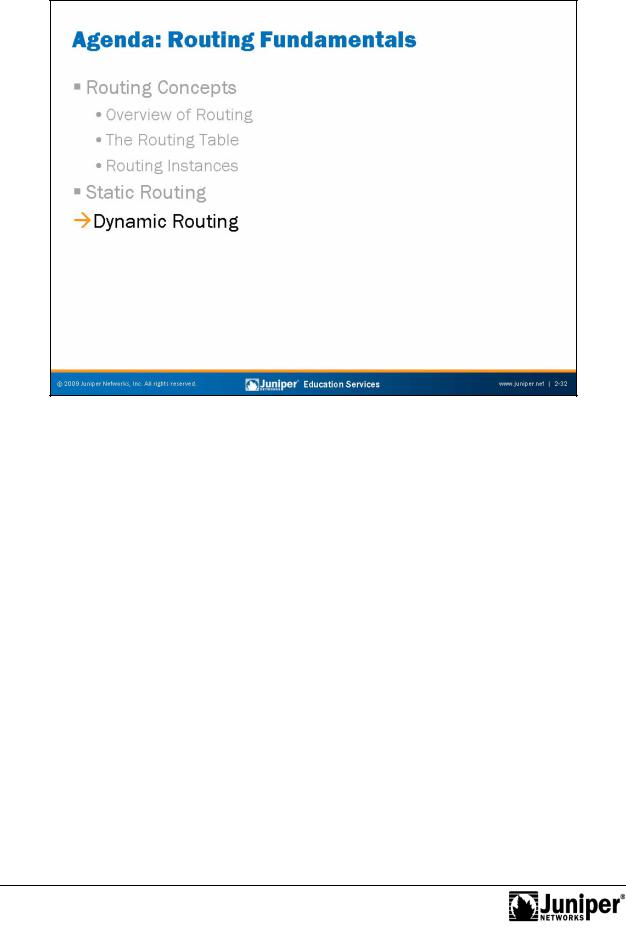
JUNOS Routing Essentials
Dynamic Routing |
|
|
The slide highlights the topic we discuss next. |
||
|
for |
Reproduction |
Not |
|
|
|
|
|
Chapter 2–32 • Routing Fundamentals
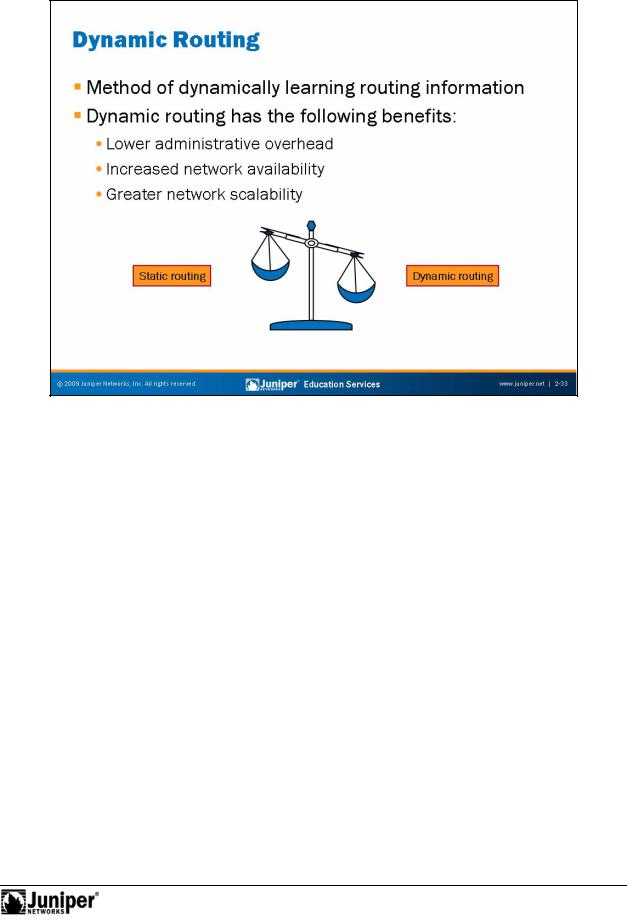
JUNOS Routing Essentials
Dynamic RoutingReproduction
Static routing is ideal in small networks where only a few routes exist or in networks where absolute control of routing is required. However, static routing has certain drawbacksforthat might make it cumbersome and hard to manage in large
envir nments where growth and change are constant. For large networks or networks that change regularly, dynamic routing might be the best option.
NotWi h dynamic routing, you simply configure the network interfaces to participate in a rou ing protocol. Devices running routing protocols can dynamically learn routing information from each other. When a device adds or removes routing information for a participating device, all other devices automatically update.
Benefits of Dynamic Routing
Dynamic routing resolves many of the limitations and drawbacks of static routing. Some of the general benefits of dynamic routing include:
•Lower administrative overhead: The device learns routing information automatically, which eliminates the need for manual route definition;
•Increased network availability: During failure situations, dynamic routing can reroute traffic around the failure automatically (the ability to react to failures when they occur can provide increased network uptime); and
•Greater network scalability: The device easily manages network growth by dynamically learning routes and calculating the best paths through a network.
Routing Fundamentals • Chapter 2–33
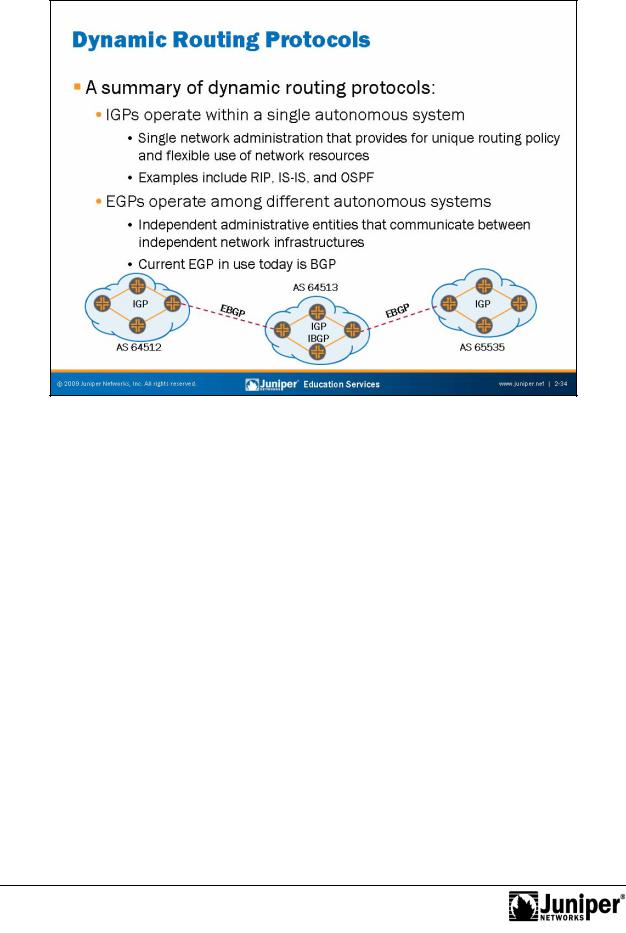
JUNOS Routing Essentials
A Summary of DynamicReproductionRouting Protocols
The slide provides a high-level summary of Interior Gateway Protocols (IGPs) and ExteriorforGateway P otocols (EGPs).
Not
Chapter 2–34 • Routing Fundamentals
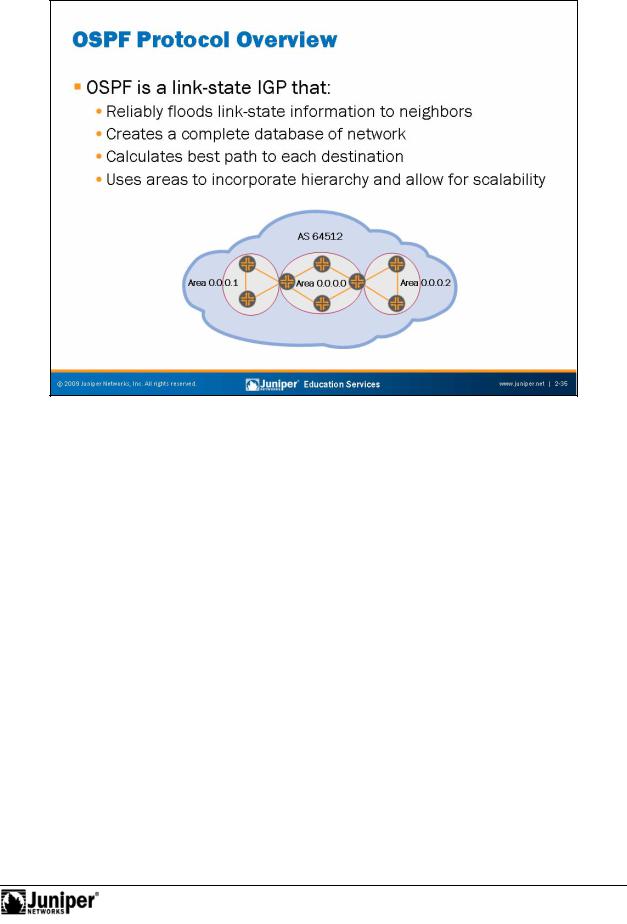
JUNOS Routing Essentials
OSPF is a link-state routing protocol designed for use within an AS. OSPF is an IGP. forLink-state p otocols allow for faster reconvergence, support larger internetworks, and are less susceptible to bad routing information than distance-vector protocols.
OSPF ProtocolReproduction
Devices unning OSPF send out information about their network links and the state of th se links to other routers in the AS. This information transmits reliably to all other
Notrou ers in the AS by means of link-state advertisements (LSAs). The other routers receive this information, and each router stores it locally. This total set of information now contains all possible links in the network.
In addition to flooding LSAs and discovering neighbors, a third major task of the link-state routing protocol is establishing the link-state database. The link-state (or topological) database stores the LSAs as a series of records. The important information for the shortest path determination process is the advertising router’s ID, its attached networks and neighboring routers, and the cost associated with those networks or neighbors.
Continued on next page.
Routing Fundamentals • Chapter 2–35

JUNOS Routing Essentials
OSPF Protocol (contd.)
OSPF uses the shortest-path-first (SPF) algorithm (also called the Dijkstra algorithm) to calculate the shortest paths to all destinations. It does this calculation by calculating a tree of shortest paths incrementally and picking the best candidate from that tree.
OSPF uses areas to allow for a hierarchical organization and facilitate scalability. An OSPF area is a logical group of routers. The software can summarize the routing information from an OSPF area and the device can pass it to the rest of the network. Areas can reduce the size of the link-state database on an individual router. Each OSPF router maintains a separate link-state database for each area to which it is connected. The link-state database for a given area is identical for all participating routers within that area.
called the backbone area. OSPF designates the backbone area as Area 0.0.0.0. All
To ensure correct routingReproductionknowledge and connectivity, OSPF mai tai s a special area
other OSPF areas must connect themselves to the backb ne f c |
ectivity. All data |
traffic between OSPF areas must transit the backbone. |
|
Not |
for |
|
Chapter 2–36 • Routing Fundamentals
